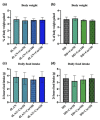Aberrant Lighting Causes Anxiety-like Behavior in Mice but Curcumin Ameliorates the Symptoms
- PMID: 34573555
- PMCID: PMC8466876
- DOI: 10.3390/ani11092590
Aberrant Lighting Causes Anxiety-like Behavior in Mice but Curcumin Ameliorates the Symptoms
Abstract
In the modern research field, laboratory animals are constantly kept under artificial lighting conditions. However, recent studies have shown the effect of artificial light on animal behavior and metabolism. In the present study on mice, following three weeks of housing in dim light at night (dLAN; 5lux) and complete darkness (DD; 0lux), we monitored the effect on body weight, daily food intake, anxiety-like behavior by employing the open field test, and expression of the period (PER1) gene. We also studied the effect of oral administration of different concentrations of curcumin (50, 100, and 150 mg/kg) for three weeks in the same mice and monitored these parameters. The exposure to dLAN had significantly increased the anxiety-like behavior and body weight possibly through the altered metabolism in mice, whereas exposure to DD caused increased anxiety but no significant difference in weight gain. Moreover, the expression of the PER1 gene involved in sleep was also found to be decreased in the aberrant light conditions (dLAN and DD). Although the treatment of curcumin had no effect on body weight, it ameliorated the anxiety-like behavior possibly by modulating the expression of the PER1 gene. Thus, alteration in the light/dark cycle had a negative effect on laboratory animals on the body weight and emotions of animals. The present study identifies the risk factors associated with artificial lighting systems on the behavior of laboratory animals and the ameliorative effects of curcumin, with a focus on anxiety-like behavior.
Keywords: PER1; anxiety; complete darkness; curcumin; dim light at night; metabolism; weight gain.
Conflict of interest statement
The authors declare no conflict of interest.
Figures





Similar articles
-
Dark nights reverse metabolic disruption caused by dim light at night.Obesity (Silver Spring). 2013 Jun;21(6):1159-64. doi: 10.1002/oby.20108. Epub 2013 May 10. Obesity (Silver Spring). 2013. PMID: 23666854
-
Dim light at night exaggerates weight gain and inflammation associated with a high-fat diet in male mice.Endocrinology. 2013 Oct;154(10):3817-25. doi: 10.1210/en.2013-1121. Epub 2013 Jul 16. Endocrinology. 2013. PMID: 23861373
-
Dim light at night does not disrupt timing or quality of sleep in mice.Chronobiol Int. 2013 Oct;30(8):1016-23. doi: 10.3109/07420528.2013.803196. Epub 2013 Jul 9. Chronobiol Int. 2013. PMID: 23837748
-
Artificial light at night alters behavior in laboratory and wild animals.J Exp Zool A Ecol Integr Physiol. 2018 Oct;329(8-9):401-408. doi: 10.1002/jez.2173. Epub 2018 May 28. J Exp Zool A Ecol Integr Physiol. 2018. PMID: 29806740 Free PMC article. Review.
-
Differential Effects of Constant Light and Dim Light at Night on the Circadian Control of Metabolism and Behavior.Int J Mol Sci. 2020 Jul 31;21(15):5478. doi: 10.3390/ijms21155478. Int J Mol Sci. 2020. PMID: 32751870 Free PMC article. Review.
Cited by
-
Potential Role of Curcumin for the Treatment of Major Depressive Disorder.CNS Drugs. 2022 Feb;36(2):123-141. doi: 10.1007/s40263-022-00901-9. Epub 2022 Feb 7. CNS Drugs. 2022. PMID: 35129813 Free PMC article. Review.
-
Adult Neurogenesis under Control of the Circadian System.Cells. 2022 Feb 22;11(5):764. doi: 10.3390/cells11050764. Cells. 2022. PMID: 35269386 Free PMC article. Review.
-
Dim Blue Light at Night Induces Spatial Memory Impairment in Mice by Hippocampal Neuroinflammation and Oxidative Stress.Antioxidants (Basel). 2022 Jun 22;11(7):1218. doi: 10.3390/antiox11071218. Antioxidants (Basel). 2022. PMID: 35883709 Free PMC article.
-
Curcumin Ameliorates the Cd-Induced Anxiety-like Behavior in Mice by Regulating Oxidative Stress and Neuro-Inflammatory Proteins in the Prefrontal Cortex Region of the Brain.Antioxidants (Basel). 2021 Oct 27;10(11):1710. doi: 10.3390/antiox10111710. Antioxidants (Basel). 2021. PMID: 34829581 Free PMC article.
-
Effects of Dietary Methionine Restriction on Cognition in Mice.Nutrients. 2023 Nov 29;15(23):4950. doi: 10.3390/nu15234950. Nutrients. 2023. PMID: 38068808 Free PMC article. Review.
References
Grants and funding
LinkOut - more resources
Full Text Sources

